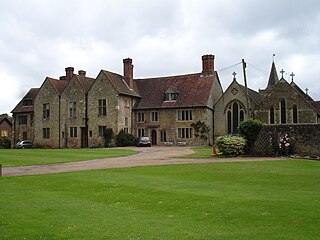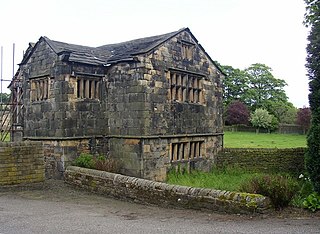Related Research Articles

Arthington Priory was an English monastery which was home to a community of nuns in Arthington, West Yorkshire, founded in the mid-12th century. The priory land is occupied by a residence called "Arthington Hall", which was built around 1585, and little, if anything, remains of the priory. The site of the priory church is possibly now occupied by a farmhouse called The Nunnery. The community was the only one of nuns of the Cluniac congregation in Yorkshire and one of two in England. It was established through a grant by Peter de Arthington.

Wilberfoss is a village and civil parish in the East Riding of Yorkshire, England. It is situated on the north side of the A1079 approximately 8 miles (13 km) east of York city centre and 11 miles (18 km) north-west of Market Weighton. According to the 2011 UK census, Wilberfoss parish had a population of 1,866, an increase on the 2001 UK census figure of 1,855.

Carlton in Lindrick is a village and civil parish about 3 miles (5 km) north of Worksop in Nottinghamshire, England. The 2011 Census recorded a parish population of 5,623, including nearby Wallingwells.

Yedingham is a village halfway between West Knapton and Allerston, nine miles north-east of Malton. It is in the Ryedale district of North Yorkshire, but was historically part of the East Riding of Yorkshire until 1974.

Ickleton Priory was a Benedictine priory of nuns at Ickleton, Cambridgeshire, England. It was established in the middle of the 12th century and suppressed in the Dissolution of the Monasteries in 1536.
Armathwaite Nunnery was a Benedictine nunnery in Cumbria, England. It was situated near the confluence of the rivers Croglin Water and Eden in the southern angle of the parish of Ainstable, and was first known as the nunnery of Ainstable.

King's Mead Priory was a Benedictine Priory situated west of Derby, in the area currently known as Nun's Street, or Nun's Green. It was the only Benedictine Nunnery in Derbyshire.
Nunburnholme Priory was a priory of Benedictine nuns in the East Riding of Yorkshire, England. It was founded during the reign of Henry II of England by an ancestor of Robert de Merlay, lord of Morpeth. Except for its demesne, it possessed only little property in its surroundings. In 1313 the prioress claimed the monastery of Seton in Coupland as a cell of Nunburnholme. In 1521 only five nuns and the prioress lived here, and on 11 August 1536 the house was suppressed. It was valued as the poorest and smallest of the Benedictine nunneries in Yorkshire surviving until then.

Nunkeeling Priory was a priory of Benedictine nuns in the East Riding of Yorkshire, England founded by Agnes de Arches or de Catfoss in 1152. It was dedicated to St. Mary Magdalene and to St. Helen. The priory became well known and nearby Keeling was renamed Nunkeeling. The priory suffered from great poverty towards the end of the 13th century. In the early 14th century several cases of disobedience among the nuns became known, leading to disciplinary measures ordered by the archbishop of York.

Swine Priory was a priory in the village of Swine in the East Riding of Yorkshire, England. The site of the Cistercian nunnery is a Scheduled Monument.

Watton Priory was a priory of the Gilbertine Order at Watton in the East Riding of Yorkshire, England. The double monastery was founded in 1150 by Eustace fitz John.

Holywell Priory or Haliwell, Halliwell, or Halywell, was a religious house in Shoreditch, formerly in the historical county of Middlesex and now in the London Borough of Hackney. Its formal name was the Priory of St John the Baptist.

Marrick Priory was a Benedictine nunnery in Richmondshire, North Yorkshire, England, established between 1140-1160 by Roger de Aske. The parish Church of the Virgin Mary and St. Andrew and 400 acres of local land also belonged to the priory, which thrived until the 16th century, in spite of the depredations of marauding Scots.

Rosedale Priory was a priory in Rosedale Abbey, North Yorkshire, England that was founded c. 1150–1199. By the time the priory was suppressed in 1535, it had one prioress and eight nuns. The religious house in Rosedale was a priory and not an abbey, despite the village being given the name Rosedale Abbey, and it is unclear why this came about.

Farewell Priory was a Benedictine nunnery near Lichfield in Staffordshire, England. Although it received considerable episcopal support, it was always small and poor. It was dissolved in 1527 as a by-product of Cardinal Wolsey's scheme to establish a college within Oxford University.

Easebourne Priory was a priory in Easebourne, West Sussex, England.

Kirklees Priory was a Cistercian nunnery whose site is in the present-day Kirklees Park, Clifton near Brighouse, West Yorkshire, England. It was originally in the ancient ecclesiastical parish of Dewsbury. The priory dedicated to the Virgin Mary and St James was founded by Reiner le Fleming, Lord of the manor of Wath upon Dearne, in 1155 during the reign of Henry II.

Black Ladies Priory was a house of Benedictine nuns, located about 4 km west of Brewood in Staffordshire, on the northern edge of the hamlet of Kiddemore Green. Founded in the mid-12th century, it was a small, often struggling, house. It was dissolved in 1538, and a large house was built on the site in Tudor and Jacobean styles by the Giffard family of Chillington Hall. Much of this is incorporated in the present Black Ladies, a large, Grade II*-listed, private residence.
Elizabeth Lorde was an English prioress of Wilberfoss. During the Dissolution of the Monasteries she surrendered Wilberfoss Priory as required by law and accepted a pension.
References
- ↑ Page, William, ed. (1974). "Houses of Benedictine nuns: Priory of Wilberfoss". A History of the County of York. 3. pp. 125–126. Retrieved 18 February 2013.
- ↑ "Lorde, Elizabeth (d. 1551), prioress of Wilberfoss". Oxford Dictionary of National Biography. doi:10.1093/ref:odnb/74101 . Retrieved 24 February 2021.
- ↑ Baines, Edward; History, Directory & Gazetteer of the County of York (1823), pp.399, 400. ISBN 1230139141
- ↑ "Church of St John the Baptist, Wilberfoss - East Riding of Yorkshire (UA)". Heritage at Risk Rigister. Historic England. Retrieved 19 March 2020.
- ↑ Historic England. "Church of St John the Baptist (1162096)". National Heritage List for England . Retrieved 10 August 2013.
Coordinates: 53°56′28″N0°53′22″W / 53.940974°N 0.889410°W
| | This article about an East Riding of Yorkshire building or structure is a stub. You can help Wikipedia by expanding it. |
| | This article about a British Christian monastery, abbey, priory or other religious house is a stub. You can help Wikipedia by expanding it. |